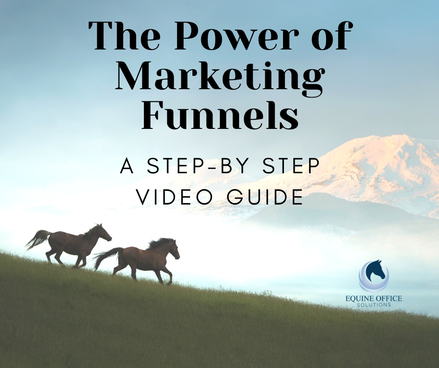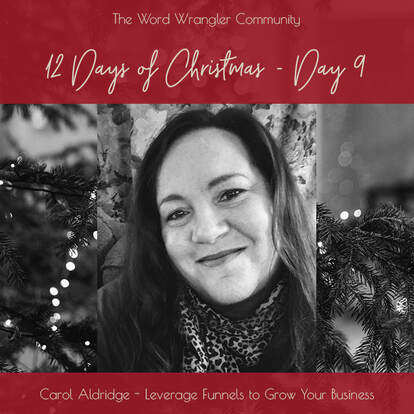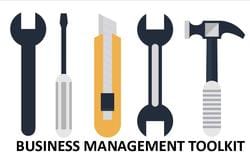Drive a continuous flow of leads and sales to your business through the power of marketing funnels!
0 Comments
Exciting news.... I’ve been invited to participate in The Word Wrangler Facebook Community’s 12 DAYS OF CHRISTMAS FREE TRAINING SERIES. On TUESDAY, DECEMBER 10th at 11:30 a.m. ET, I’ll be discussing the topic of “Leveraging Funnels to Grow Your Business”.
This Facebook Live presentation will explain what a marketing funnel is, the components of effective, integrated systems and how anyone can build a simple funnel to begin marketing more effectively. Here's the full lineup: Dec 2 - Kelsey Keathly with Norfleet Marketing - Your Brand is More Than your Favorite Color Dec 3 - Schelli Whitehouse With The Equine Inspired Life - Let's Adjust Your Money Mindset Dec 4 - Melody Semmler with Equine Entrepreneur - Finding Your Ideal Client Dec 5 - Nicole J Weis with Nicole Jolene VA - Serve Your Clients Better and Improve Your Work-Life Balance with a VA Dec 6 - Maureen Doss with Doss Virtual Solutions - Make Systems Work For You Dec 7 - April Hardeman with Make it Rein - Make More Money with a Membership Dec 8 - Laura Langfitt with Unbridled Content Marketing - Make Content Marketing Work for You Dec 9 - Heike Jung with Horse World Connect - Grow Your Business with a Podcast Dec 10 - Carol Aldridge with Equine Office Solutions - Leverage Funnels to Grow Your Business Dec 11 - Jamie Samples with Yellow Barn Media - Email Marketing is for EVERYONE Dec 12 - Shelley Paulson with Shelley Paulson Photography - How to Take AMAZING Photos for Your Business. Dec 13 - Deanna Corby with Level Up Equestrian - Video Marketing 101 To access the live presentations and REPLAYS, join the Word Wrangler's Facebook Group here: https://www.facebook.com/groups/thewordwranglers Then, to receive notifications for each presentation, just RSVP on their events tab. I hope you’ll join us! See you there! By: Carol M. Aldridge Driving quality traffic to your website is key to increasing your qualified leads and conversions. Of course, you can pay for traffic through social media ads and Google AdWords, but there are many other ways to drive targeted traffic as well, that won't cost you a dime. OPTIMIZE YOUR WEBSITE To assure you have the best chance of converting leads into customers, the first place to start is by making sure your website is optimized for visitors and search engines. Even if your promotions are getting clicks, if the user experience and content on your site are not of value to your visitors, your conversion rates will be low. Ways to optimize your website for conversion:
TYPES OF CONTENT Some content will simply drive traffic, increasing your SEO and building trust. Other types of content will serve as lead capture tools, allowing you to gather email addresses, moving your prospects through your sales funnel and providing other key demographics for your future follow-up. Consider a mix of the following when creating your content:
ATTRACTING CLICKS So you've optimized your website. Your awesome content is ready for the world to see. Now, how do you get your audience from point A to point B? Backlinks. By sharing links to your content through a variety of platforms you will maximize traffic and leads.
OTHER SOURCES OF FREE TRAFFIC
PAID TRAFFIC
LEARN FROM YOUR ANALYTICS Google Analytics is a powerful tool, especially when used in conjunction with the reporting provided through your social media pages, email marketing platform and website. Tracking your sources of traffic will help you understand what's working and what's not. In conclusion, attracting quality website traffic takes some time & effort. However, each step you take will garner greater results. Start slow, build your efforts over time and track your analytics. You will consistently increase quality traffic & qualified leads, ultimately converting those leads into customers. Let's connect. If you found this information helpful, or if you have questions or suggested topics for future articles, send a quick email and let me know. I'd love to hear from you and will respond personally. If you'd like help implementing these recommendations and growing you your equine business, let's schedule a complimentary Discovery Session to explore how we can best reach your goals together. RESOURCES: Moz: It's Content & It's Links - Are We Making SEO Too Complicated? https://moz.com/blog/are-we-making-seo-too-complicated HubSpot: 27 Ways to Drive Traffic to Your Website https://blog.hubspot.com/marketing/increase-website-traffic Quicksprout: 25 Ways To Increase Website Traffic https://www.quicksprout.com/increase-website-traffic/ WordStream: Increase Traffic To Your Website https://www.wordstream.com/blog/ws/2014/08/14/increase-traffic-to-my-website
When my clients tell me they just can't find the time to market their business, I GET IT! In fact, you may have noticed my blog posts and email newsletters have been missing for a while. As a business owner who is also a single Mom with a full-time job, I was struggling to keep up. You guessed it. Life got in the way. Thankfully, I've recently shifted my priorities to better align with my vision. I've said "no" to some volunteer requests and brought on several fabulous, new team members for my business. I'm now back on track! In fact, I have some exciting announcements coming soon, so stay tuned and join me as we continue to bring you valuable marketing content to help you move your business forward.
Watch for our upcoming post, "How to Drive 10x More Traffic to Your Equine Website", coming soon! And to assure you don't miss a single article on how to grow your business, be sure to SUBSCRIBE to our newsletters. You'll also receive our FREE EBOOK, "THE ZERO-BUDGET MARKETING PLAN for Equine Business Owners - A Resource Guide: Leveraging Today's Best Free Marketing Tools For Widespread Visibility" You’ve most likely heard the term “SEO” but, what does it really mean, and is it something your equine business needs to be concerned about? In this article, we will de-mystify the world of SEO and explain why it is highly recommended as a means of successfully marketing your business! SEO, when used correctly, can drive high-volume, qualified leads to your website, as well as increase your ranking with Google and other search engines.
WHAT IS SEO? Search Engine Optimization (SEO) is the process of improving internal and external aspects of a website to increase its visibility for search engines. Search engines index the information contained on your site to determine where, on the search results page, your website will display. The goal of properly developed SEO, is to have your business’ information show up within the first page of the search results. Like the old real estate saying goes, “location is everything” and that certainly applies to your business’ SEO rankings! Be forewarned, this is not a simple process, however, quality traffic means increased revenue and more publicity. Search engine optimization can lead to an organization’s success or failure. You may be wondering, “What about paid internet advertising?” The majority of online traffic is driven by search engines! According to Britney Muller , MOZ.com Staff Writer, “While paid advertising, social media, and other online platforms can generate traffic to websites, the majority of online traffic is driven by search engines”. SEO-RELATED TERMS THAT ARE IMPORTANT TO UNDERSTAND KEYWORDS Keywords are the terms and/or words your clients (and potential clients) will use in their online search for the type of services your business offers. Proper keyword research & the use of relevant keywords throughout your site’s content, titles, metadata and all your promotions is of utmost importance. TARGET MARKET/IDEAL CLIENT Knowing your Ideal Client or Target Market is vital to the success of any business because it gives focus to your marketing efforts. It is imperative that you build relationships with this specialized group of potential clients. Recommended ways to build these relationships are through blogging, social media, SEO, direct mail, newsletters, articles and videos. A potential client that comes to know, like and trust you is more likely to become a paying client! All of your promotional efforts should focus on how you can meet the needs of your target market. QUALITY CONTENT When you place quality content onto your website or social media, it will qualify you as an authority in your field of expertise. The content you place on your website or social media is the most CRUCIAL FACTOR for your online business and is absolutely necessary for enhancing your SEO and attracting a focused and engaged audience. WEBSITE ELEMENTS THAT IMPACT SEO HEADER TAGS Header tags are part of the HTML coding for a web page and carry a lot of weight with the search engines because they’re for categorization, not cosmetics. They usually reflect the title of the page or blog post. If your visitors understand the header on your page, the search engine will likely be able to do so as well. If you pay special attention to the keywords in your titles and header tags, your click-through rate should rise accordingly. LANDING PAGES A Landing Page is a page that focuses on information that interests a specific target market or ideal client and are often used to elicit a ‘call to action’ such as prompting a visitor to: • click (to go to another page, on your site or someone else's) • buy something • give you permission to follow up with them (opt-in) • refer your page to someone else • learn something • post feedback or a comment When visitors take action on your webpage it verifies the validity of your site with the search engines and raises your SEO. BLOGS Publishing quality content of interest to your audience, and then sharing backlinks on social media is the #1 way to enhance your SEO! A backlink is a reference from another source to your web page. According to Wikipedia, “The quantity, quality, and relevance of backlinks for a web page are among the factors that search engines like Google evaluate in order to estimate how important the page is. Having relevant comments on your blog posts will also help you garner more traffic. SSL CERTIFICATE The last topic concerns having a valid SSL Certificate for your website. What is an SSL certificate? An SSL certificate is a digital document that ensures the content provided is from the correct (verified) sender. An SSL certificate is a security certificate that once installed on a web server activates a secure connection between the browser the surfer is viewing the content on and the web server that the content is derived from initially. Google has announced that as of July, 2018, websites accessed via Chrome must have a valid SSL Certificate or the visitor will receive a security warning. When you secure a valid SSL Certificate your website’s URL protocol will change from HTTP:// to HTTPS://. SSL certificates help the web cut down on instances of cybercrime that are often performed through security loopholes in web browsers. For site owners who have lagged on adapting their site to HTTPS encryption, time is indeed running out. Non HTTPS websites will undoubtedly be exposed to the risk of lost search rankings and overall, less traffic. PPC ADS Google AdWords and paid social media ads are also extremely effective ways to increase your web traffic and quickly raise your ranking with the search engines. Take special care to assure professional methods are used to create and manage these ads. Although it may take a few weeks to see results, when implemented properly, the payoff will often well exceed the investment. CONCLUSION: Depending on your bandwidth, willingness to learn, and the complexity of your website(s), you could perform some basic SEO yourself. Or, you might discover that you would prefer the help of an expert! Either way, it's clear that the effort you put into enhancing the SEO of your website will ultimately pay off. And conversely, if you choose to ignore the factors that effect SEO, the growth and success of your site and ultimately your business will struggle to reach their full potential. Equine Office Solutions specializes in implementing high performing marketing funnels, customized for your business and designed to increase your website traffic and that all-important SEO! Contact Us for a complimentary discovery session to learn how you can put our experience to work for you.  You may think, “I’m too busy to manage social media for my business”. However, the key to successful inbound marketing is to find out where your audience is and increase your visibility there. Therefore, with over 1.7 billion users logging on daily, you can’t afford not to be on Facebook. THE BENEFITS OF SOCIAL MEDIA MARKETING Interactive communication with your audience The beauty of social media is that it provides the opportunity to communicate directly with your audience. It’s the “social” in social media that allows for conversations to take place. For instance you may post an image that is of particular interest to your audience and ask them to share their personal experience or thoughts on the topic. Widespread Visibility Social media is a key strategy for any inbound marketing campaign. Consistently posting a variety of content that speaks to your audience’s needs and interests will enhance awareness and engagement for your business exponentially over time. Enhanced Search Engine Optimization (SEO) One of the key goals when posting content on Facebook and other social media sites is to drive traffic back to your website. By posting fresh content on your site (blog posts, sale items, etc.) and sharing links to that content on social, you will drive more traffic and visitors to your site which in turn will enhance your ranking with Google. Simple as that. Increased leads and subscribers Your website is your home base. It’s where you are able to convert visitors into qualified leads, and leads into customers. By occasionally posting offers to intriguing, valuable, original content (video series, ‘how-to’, article, eBook, etc.) that require an email address for access, you will increase your leads and subscribers and gain permission to stay in contact with them via email. EFFECTIVE FACEBOOK MARKETING TACTICS Business Page vs. Personal Profile One of the main reasons you shouldn’t use a personal profile page to promote your business is that it goes against Facebook’s Terms of Service. However, you can share your business page posts on your personal profile for even greater visibility. However, a Facebook Business Page provides the ability to increase audience reach by creating advertisements that target more people than just friends of your friends. With a Business Page, you can actually get feedback and monitor analytics for your page to determine the preferences of your audience and how many likes and shares your page and posts are generating. Ads and Boosted Posts When it starts getting hard to pierce through the noise of your competition, Facebook offers your business page away to boost your posts’ visibility. You can distribute boosted posts to potential clients based on demographics and interests. You can also choose who to target based on age, gender, location, and interest. Facebook Ads provide a powerful marketing tool that uses enhanced targeting criteria to reach a specific, focused audience. With a straightforward interface, you have complete control over your advertisements. Overall, Facebook Ads are much less expensive than traditional forms of advertising, with greater visibility to those who are more likely to be interested in what you have to offer. Live Video Videos are known to garner a stronger engagement rate from audiences. That’s why Facebook Live has been so popular since it launched, simple posts may not always be enough. That’s why Facebook has designed Live videos to work a little differently, built to boost more visibility to audiences. The authenticity of live videos allows you to connect on a deeper level with your audience and interact with them in real-time. Building anticipation for the event through teasers and offering rewards encourages more subscribers. A compelling title and description title will help the event stand out among others. While it should appear to be unrehearsed and unscripted, it’s a good idea to know what you’re going to talk about ahead of time and limit the length of your video to prevent ramblings and hold the attention of your viewers. To create a more compelling video, utilize the front and rear-facing camera to both showcase and give a behind-the-scenes look into your business. Acknowledge the audience every so often either by answering questions and comments while shooting the video. The Benefits of Groups Facebook groups are communities of like-minded people who come together to share ideas and interests. Reach out to new customers and make new connections by joining groups related to your business or create your own group. Engaging with group members by offering help and support will provide visibility and help establish you as a thought leader in the industry. Mobile vs. Desktop In this era of users on the go, mobile has become the primary medium for accessing social media newsfeeds. Keep this in mind when creating image and video content, and follow Facebook’s guidelines regarding resolution, file size & dimensions. BUILDING THE PERFECT POST Create and Share Stand-Out Content One of the first goals for content posts on Facebook is to always be creative and address the interests of your audience. Remember, you are competing with family, friends, and competitors for attention and should strive to break through the noise of the other posts and content that constantly flow through the audience’s news feeds. Attention Grabbing Headlines Grabbing the audience’s attention is the first step in getting them to read your content. Create headlines with “thumb-stopping” action to make viewers want to pause and read the post or watch a video. Titles need to be descriptive, but it should be short and simple so don’t go overboard. When posting content that links to a blog, video, or an article, add engaging quotes from the linked content to draw in audience interest. Emotional Connections Draw in audiences by evoking sentiment, by making them laugh, or by contributing positively to their day. Creating an emotional connection is a great way to create impact and help your posts stand out. Timing & Scheduling Posts Timing is everything, and the right timing is important to ensure your audiences are even going to see your content. It’s a good idea to avoid hours when your audiences might be asleep or at work. Even if you can’t always be around to post content, there are sites like Hootsite and Buffer that allow you to schedule posts and publish them for you automatically. GOALS & MEASURING SUCCESS Setting specific goals as related to key performance indicators such as increased number of fans, engagement (likes, comments & shares), conversions (subscribers, clicks, sales, etc.) and then measureing the success of each post and ad through the use of FB insights, google analytics and reports available through social media scheduling tools such as Hootsuite or Bufferapp, will clearly define the topics, posts and type of content that best resonates with your audience. This final step with ultimately make your efforts worthwhile because without a clear understanding of what’s working and what’s not, there can be no true success. GUEST AUTHOR: LARISSA HOLMES Larissa is a graduate of the University of Findlay with a degree in English & Equestrian Studies, and served as a summer intern with Equine Office Solutions. ADDITIONAL RESOURCES: 5 Tips to Creating an Unbeatable Facebook Ad Campaign https://blog.kissmetrics.com/unbeatable-facebook-ad-campaign/ 10 Little-Known Facebook Marketing Features and Hacks You Can Try Today https://blog.bufferapp.com/10-hidden-facebook-marketing-features Success Stories | Facebook Marketing Partners https://www.facebook.com/business/success 8 Reasons Facebook Will Beat All Other Digital Marketing Channels https://www.entrepreneur.com/article/286441 Facebook Video for Marketers: Strategy for Future Success http://www.socialmediaexaminer.com/facebook-video-for-marketers-strategy-for-future-success-jay-baer/ 5 Benefits of Using Facebook Live Video http://www.business2community.com/facebook/5-benefits-using-facebook-live-video-01773422#vZ86GkOMcMwCTbOL.97 Five Crucial Tips for a Successful Boost Post on Facebook https://komarketing.com/blog/tips-for-successful-facebook-boost-posts Tips for Using Facebook Live https://www.facebook.com/facebookmedia/best-practices/live Facebook Live – What Marketers Need to Know http://www.socialmediaexaminer.com/facebook-live-what-marketers-need-to-know How to Choose Between Facebook Profiles, Pages, and Groups http://www.socialmediaexaminer.com/marketing-your-business-on-facebook-how-to-choose-between-profiles-pages-and-groups  The unique, patented BEMER signal has revolutionized the medical field. Over 18 years of successful testing has resulted in 5 worldwide patents and a million+ users including top level athletes, whole sports teams, and a cooperation agreement signed with NASA. The unique FDA Registered device is proven to enhance blood flow, resulting in increased oxygen supply, enhanced recovery & regeneration processes, reduced stress and improved hydration. And now, this ground-breaking technology has been adapted to meet the specific requirements of equine athletes. “BEMER is taking the equestrian industry by storm! Short, daily sessions are natural and safe, assisting with optimum performance for both horse and rider.” –Candice King, World Class Grand Prix Show Jumping Champion and USET Gold Medalist with multiple FEI Titles and Awards. “After using the BEMER Vet on countless horses, I have seen remarkable improvements in performance, behavior and health. Horses love the BEMER and you will too!” –Linda Tellington-Jones, Hon. Ph.D, Animal Ambassador, Teacher, Trainer and Author of 21 books in 15 languages. The new BEMER Vet for horses will premier March 15-April 2 at the Winter Equestrian Festival in Wellington, FL. Contact Carol Aldridge to learn more, and be among the first to receive priority information when their new shipment arrives. Then plan to visit eTherapy Equine’s booth near ring 9 to schedule your personal demonstration. Carol Aldridge has partnered with eTherapy Equine as their Digital Marketing Manager and East Coast distributor. eTherapy Equine is managed by Chris Raborg Insurance Services, Inc., distributor of BEMER Vet for the 2017 Winter Equestrian Festival. BEMER was founded in 1998 by Peter Gleim and now operates in the medical engineering sector, conducts and supports research in the area of microcirculation, and develops physical treatment procedures to positively influence the aforementioned. The multi-patented and market-leading technology of the physical vascular therapy BEMER is available in different, innovative product lines, which the company distributes through its own, widely spread direct specialist distribution and the corresponding local representation in over 40 countries. The company’s registered office is in Triesen, Liechtenstein, where over 50 employees are employed. For more information, contact: Carol Aldridge Carol@EquineOfficeSolutions.com Ph: (859) 361-9416 Equine Office Solutions is seeking a stand-out intern with a focused desire to gain in-depth knowledge of today's best inbound marketing practices. Proven, professional writing skills and the desire to learn prominent online applications and marketing strategies required.
This position will provide hands-on learning experience in creating and implementing interconnected systems associated with company branding, lead generation, seo, email marketing, media relations, content marketing, online event management, social media. website management, designing marketing plans, analytics and more. Duration: approximately 3-5 hours per week. Internship may be structured to best suite student's schedule. Minimum 3 month commitment. Compensation: College credit if applicable To Apply: Send cover letter, resume, writing samples & references to Carol@EquineOfficeSolutions.com Did you know that you can create a historical Facebook archive by downloading all of your posts and data, including images, messages and more? Just go to "Settings" and in the "General" tab you'll see an option to "Download a copy of your Facebook data". You'll be asked to enter your password, and a few minutes later you will receive an email with a download link. My personal Facebook page archive downloaded today contains 43mb of data, and includes just about everything, even a history of the people I've poked! LOL. But seriously, this is a valuable option for securing your data, so give it a try, then leave a comment below. I'd love to hear your thoughts.
Being a business owner and entrepreneur means wearing many hats, all the time. Fortunately, in this ever-advancing age of technology, there are a multitude of valuable, web-based tools to help you efficiently and effectively manage your business.
Here are some of the best: 14 Free Business Tools for 2017 |
CategoriesArchives
August 2023
|











 RSS Feed
RSS Feed